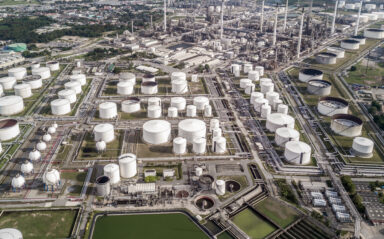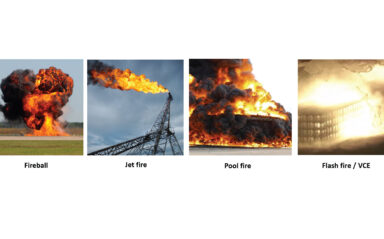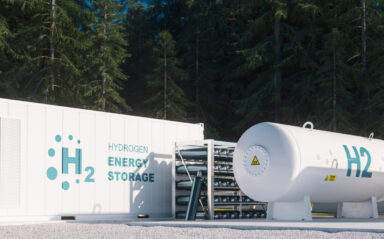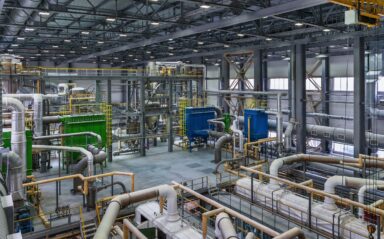
How to do a Quantitative Risk Assessment (QRA)
This article discusses the main steps required to perform a QRA to evaluate all potential loss of containment scenarios involving the release of dangerous chemical substances in process, chemical and petrochemical facilities.

The safe use of hydrogen as an energy carrier
We can ensure the safe production, transportation, and usage of hydrogen by carefully considering its typical properties and associated safety aspects.

CO2, energy transition and champagne!
In an earlier blog, we talked about some energy carriers playing the main role in the energy transition, hydrogen, and ammonia. Strongly linked to that is also CO2, which possibly is not so obvious.

Societal Risk maps as a clear geographical representation of risk
This blog provides some background about these geographic presentations of Societal Risk and explain how to interpret their results when using Gexcon’s risk modelling software RISKCURVES.

How to simulate plumes of large fires in EFFECTS
Both pool and warehouse fires can result in highly toxic fumes. The assessment of the toxic concentration levels of these combustion products transported along the plume trajectory is of utmost importance. Safety professionals can use this information for hazard identification, safety analysis and emergency planning.

Safety aspects of new energy carriers
Today, two of the new energy carriers are hydrogen and ammonia. When used at a large scale during the energy transition process, the safe handling of these energy carriers plays a major role.

Fire and explosion hazards: What to expect if there is a leak
This article will explain the importance of assessing the consequences of a potential release of a hazardous chemical substance and introduce you to the different dangerous phenomena that can occur upon such a loss of containment scenario.

How to simulate tank pit fires in EFFECTS
Heat radiation from a pool fire causes a heat flux with the potential to cause damage to objects in the surrounding area.
That is why it is highly relevant to assess the consequences of such a scenario to help safety professionals devise prevention and mitigation measures so that accidental releases can either be prevented or their consequences minimized.

Why software validation is important
Numerical models simplify reality; usually, they only model the relevant physical processes. A verification process assesses the software implementation to ensure the correct coding and elimination of errors.

Geographic Information Systems (GIS) made easy in EFFECTS
In this blog post, Sonia Ruiz, Gexcon’s Research Scientist, explains how easy it is to use background maps in EFFECTS.

Ammonia Risk Assessments – How advanced consequence modelling can improve safety management
Advanced consequence modelling can improve ventilation/dilution levels and detection times from common leaks during ammonia risk assessments.

Why Safety Risks DO Matter
To provide insights on safety, we should try to answer: “What can go wrong?”, “What are the consequences?” and “Why safety risks DO matter?”

High Flash Point Liquids – does the approach for hazardous area classifications need to change?
The Energy Institute Model code of safe practice Part 15 provides an approach to assess high flash point liquids for Hazardous Area Classifications.
However, recent studies indicate that the approach may be over-conservative in some instances, resulting in potentially unnecessarily high costs.

Celebrating our community of FLACS-CFD users
Chris Coffey, FLACS-CFD Product & Strategic Business Development Manager, reflects on the success of Gexcon’s very first FLUG Week.

Designing bulk hydrogen storage using CFD – Why it is important
Using our flagship CFD modelling tool FLACS-CFD, Gexcon conducted several case studies on real facilities looking at the design of bulk storage areas in terms of safety during an ignited event, using relevant standards and documentation for guidance.

Introduction to HAZID (Hazard Identification)
The high-level nature of a HAZID is suitable to review the design at an early stage without requiring in-depth knowledge of the operation.

Dust explosion: an introduction
Did you know that dust could explode? In fact, powdered milk, flour, sugar, and cornstarch, among many others, can explode.
There have been some devastating incidents that have taken place over the past decades caused by dust explosions.

Introduction to ATEX Directives
ATEX is a set of two European Union Directives that have been established to protect employees from explosion risks within industries.

Passive Fire Protection (PFP): a brief guide
PFP is a vital construction element installed in a building or on process equipment that prevents or slows down the spread of fire

Working with the UK’s first ever multifunctional LNG Terminal.
Gexcon Consulting recently worked with the UK’s largest LNG storage facility located on the Isle of Skye, Scotland. The facility is located at a fish feed production factory and therefore presents a very different level of risk than the primary operations.